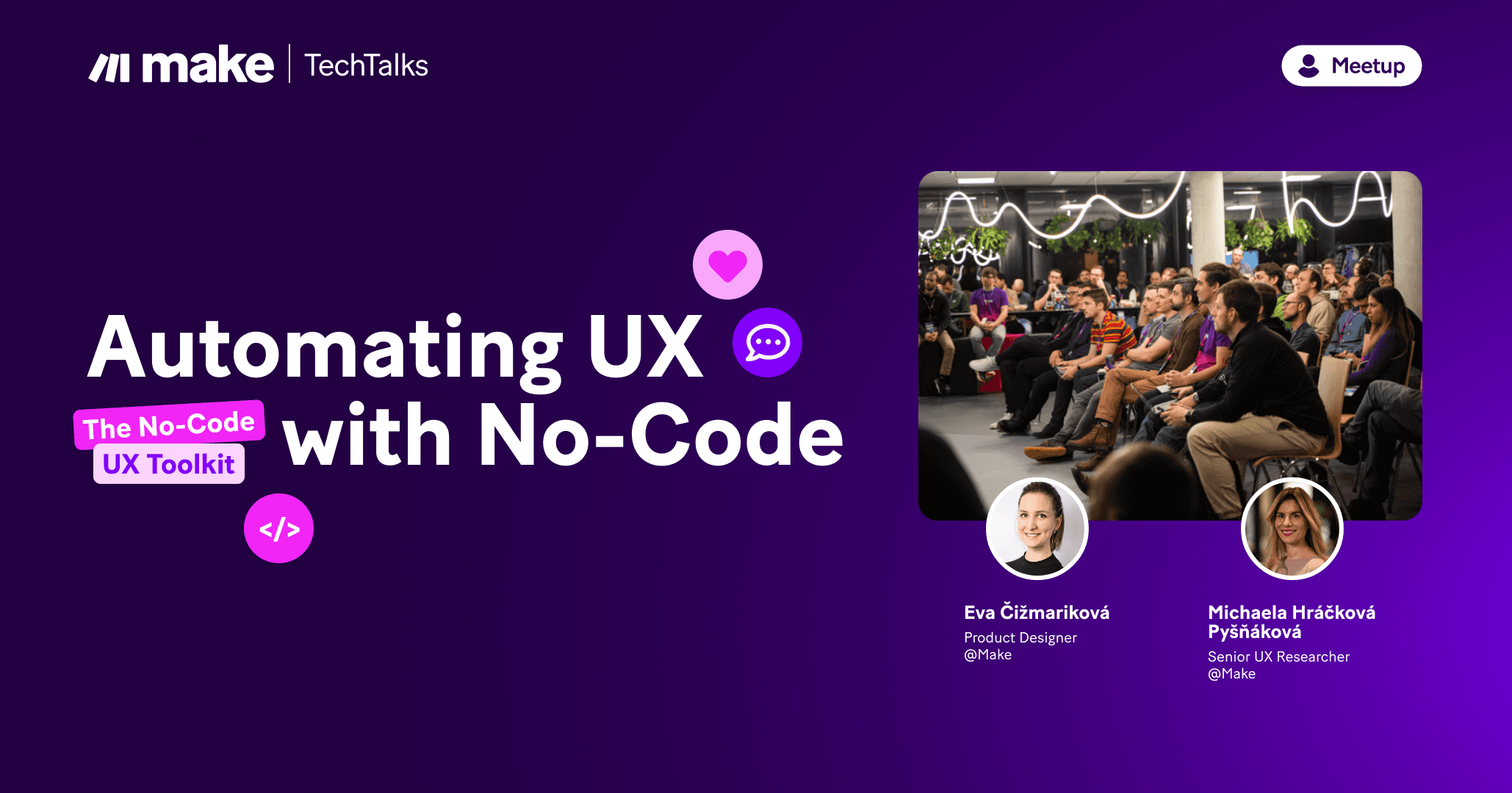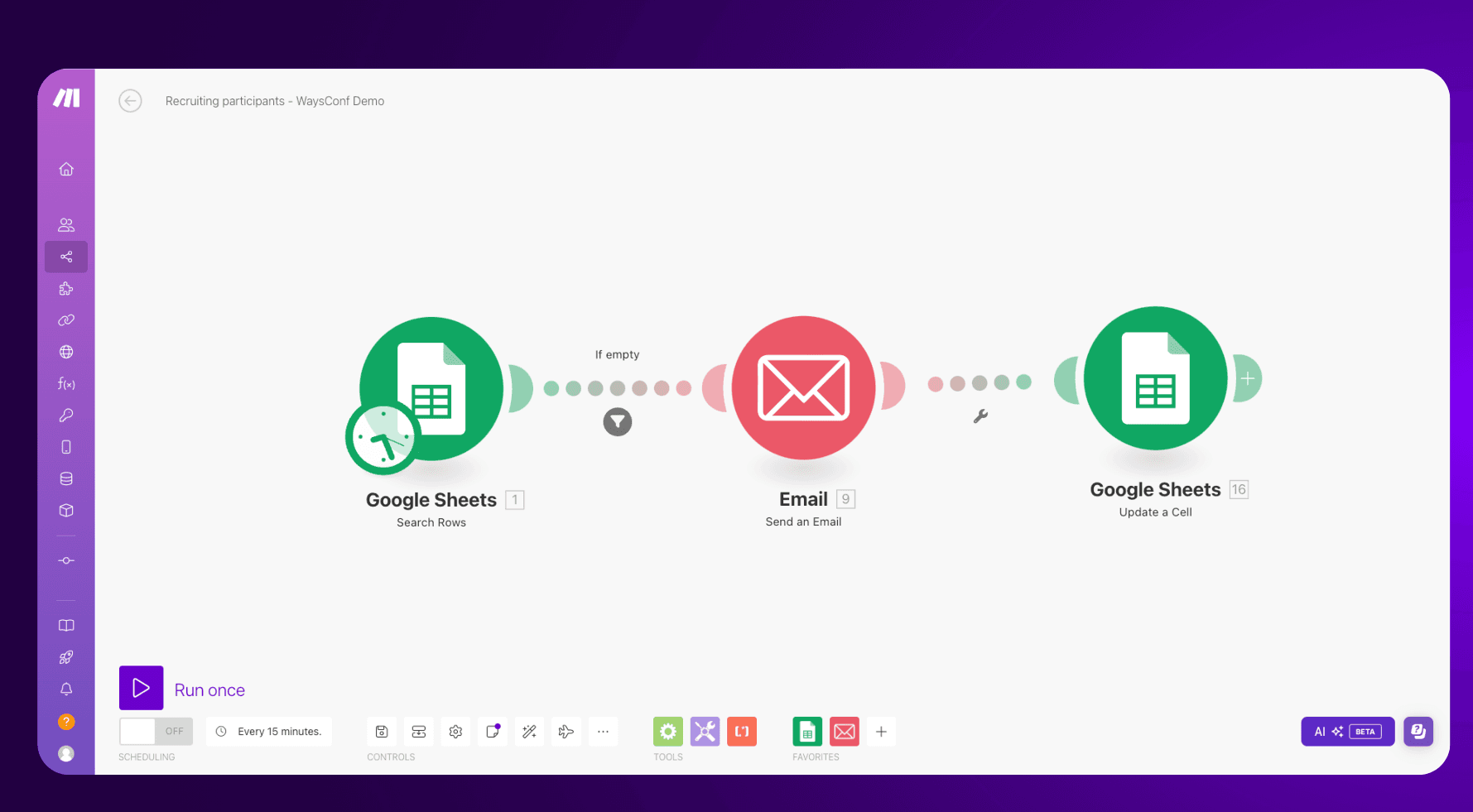Nov 21, 2024 | 4 minutes
Make TechTalks: Automating UX with no-code

Ever wondered how UX and automation can work together to transform user journeys?
We recently kicked off the event season at our HQ in Prague with a TechTalk meetup focused on this exact topic.
Joined by more than 60 passionate UX professionals, Make’s own Michaela Hráčková Pyšňáková and Eva Čižmariková shared their fascinating insights from working at the intersection of automation and UX.
Missed the event? Here’s a recap of what they had to say.
Turning overwhelm into innovation with Make and AI
Michaela, a Senior UX Researcher at Make, and Eva, a Product Designer at Make, revealed how they use a powerful combination of AI and no-code automation to transform their approach to UX – especially when it comes to research.
Working as part of a small (but growing) UX team, Michaela and Eva shared their struggles with keeping up with high research demands and detailed how they overcame these challenges.
Michaela said: “Talking to users is exciting, but it can be overwhelming. We had no time. We were stressed. We thought ‘how can we use Make to help us with this problem?’”
Together, Michaela and Eva developed innovative use cases, which they shared in detail during their talk.
Use case #1: Tracking, prioritizing, and planning UX research requests
With a steady stream of requests for UX research from across the organization, Michaela and Eva needed a way to keep on top of everything.
They also wanted to remove the time-consuming manual task of informing colleagues about whether their request was successful and coming up with a plan of action to kick off the research.
Using Make as a no-code visual automation platform, they set up two scenarios that enabled them to automatically:
Collect research requests using Google Forms, Google Sheets and Google Docs
Notify the UX team in Slack when a request was made
Inform stakeholders if their request was approved with a Slack message that also contained suggested next steps
Use case #2: Saving time on user invites and incentives
Recruiting users to take part in UX research is critical to the success of any UX study – but Michaela and Eva were finding that manually sending personalized invites was a huge drain on time and resources.
They set up a simple but powerful scenario using Google Sheets and Gmail that enabled them to automatically:
Send personalized research requests with placeholders for name, plan type, and incentive
Track who received research invites and incentives
Use case #3: Summarizing UX interviews for the wider team
With each UX research study taking three to five months to complete, Michaela and Eva wanted a way to share outcomes from research interviews with the wider team to increase collaboration and maintain engagement.
They created a scenario that automatically:
Uploads Zoom interview transcripts as soon as a session ends
Uses OpenAI to create a clear, concise summary of the interview
Shares the summary to a dedicated Slack channel
Use case #4: Analyzing qualitative UX survey responses
Qualitative feedback is essential in UX research, offering deep insights into user behavior, needs, and pain points.
However, analyzing open-ended survey responses can be incredibly time-consuming, especially when patterns and themes need to be identified manually.
To address this, Michaela and Eva created a scenario in Make that automatically:
Uploads and analyzes responses using OpenAI and Google Sheets
Creates and assigns labels related to common themes, such as ‘easy to use’ or ‘saves time’
Statistically measures the frequency of labels
Michaela shared important insight about her learnings on boosting the reliability and accuracy of the AI analysis of the data during the session. She said: “It’s important to remember that AI is a skilled intern. You are the pro.”
Successes – and setbacks
As well as sharing their successes with using Make and AI to boost the impact of their UX research, Eva also shared useful insights on attempts to use it that didn’t work out so well.
She shared an example where a scenario designed to generate user personas from interview notes proved unreliable, missing key context that only human analysis could provide.
She said: “AI is a tool that can boost the impact we have, but it’s important to be aware of its limitations.
“It can open up new possibilities but it will not replace us.
“However, it has given us more time for the fun, creative parts of our jobs that we love.”
Catch up with the full session
Watch the full recording of Eva and Michaela’s presentation to discover how you can try out their scenarios for yourself.







